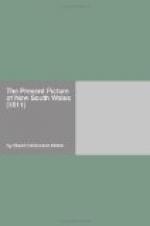About this period, a mare, belonging to a settler named Roger Twyfield, at Hawkesbury, produced a foal, without any fore-legs, or the least appearance of any: it lived for some time, fed very well, and, exclusive of its natural deficiency, was in every respect a remakably well-made animal. Such a singular phoenomenon in nature has no parallel in my recollection; and I believe it is the only instance of an imperfect or deformed progeny in the settlement. Previous to the death of this singular animal, an appearance of a horn was discovered sprouting from its forehead; assimilating it, in some degree, to the supposed unicorn.
Chapter II.
Abstract of General Orders.—Arrival of Governor Bligh.—George Barrington.—Blue Mountains.—Journey thither.—New Market at Sydney.—Vessels seized and carried away by the Convicts.—Natives.—Cruelty of the Savages in Bateman’s Bay.—Arrival of Masters for the Orphan Schools.—New Storehouse built.—Murders.
Of the General Orders which were issued for the government of the settlement, I shall here give the following abridgment, as it will shew to the reader the nature of the regulations which were adopted in the colony:—
Agreements—not cognizable, unless written and registered; being witnessed by one person, not a prisoner.
Apprentices and Deserters—forbid to be harboured or inveigled, under the penalty of six months hard labour, exclusive of penalties by law ordained, if free; and, if a prisoner, one hundred lashes, with other penalties, at discretion of a bench of magistrates.
Arms and Ammunition—prohibited to be landed without permission, under the penalty of forfeiting bond and charter-party.
Assault.—Every description of persons to obtain redress by action or indictment; and persons beating prisoners assigned them, to forfeit such future indulgence.
Assignments—not cognizable, unless drawn up at the judge-advocate’s office and registered.
Bakers—to make bread of one quality only; viz. 24lbs. of bran to be taken from 100lbs. of wheat: to charge 4d. in money, or 2 1/2 lbs. wheat, for a loaf weighing 2lbs. 1oz. when new, and 2lbs. if one day old, under the penalty of 5L. and otherwise at discretion of a bench of magistrates.—[Since the above regulations were made, a much more regular system has been adopted to fix the price of bread. On every Saturday morning, a bench of magistrates assemble to hear the price of wheat, and affix that of bread for the ensuing week, according to the rate wheat has been sold at.]




